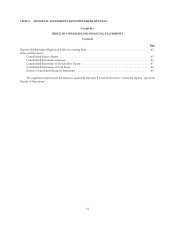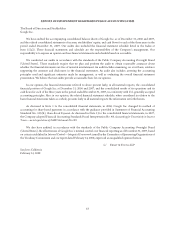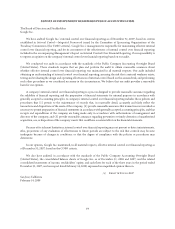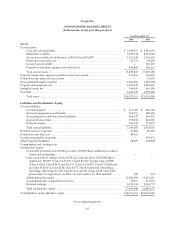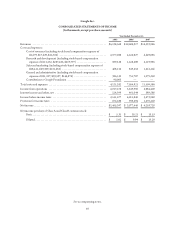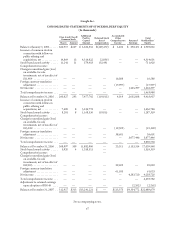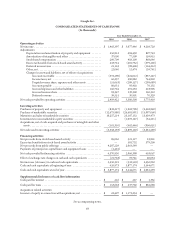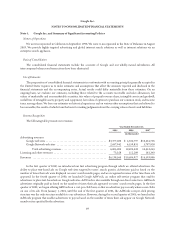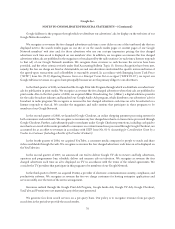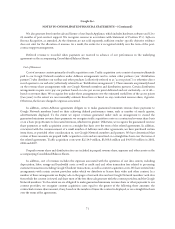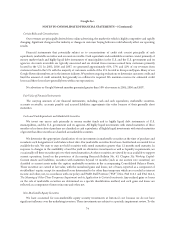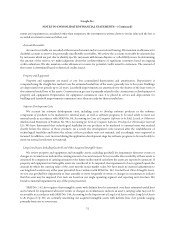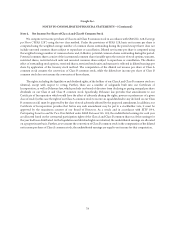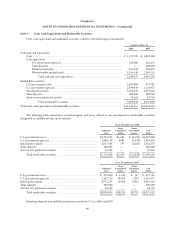Google 2007 Annual Report Download - page 86
Download and view the complete annual report
Please find page 86 of the 2007 Google annual report below. You can navigate through the pages in the report by either clicking on the pages listed below, or by using the keyword search tool below to find specific information within the annual report.Google Inc.
NOTES TO CONSOLIDATED FINANCIAL STATEMENTS—(Continued)
Stock-based Compensation
Prior to January 1, 2006, we accounted for employee stock-based compensation using the intrinsic value method
supplemented by pro forma disclosures in accordance with Accounting Principles Board (“APB”) Opinion No. 25,
Accounting for Stock Issued to Employees (“APB 25”) and Statement of Financial Accounting Standards (“SFAS”) No. 123,
Accounting for Stock-Based Compensation (“SFAS 123”), as amended by SFAS No. 148, Accounting for Stock-Based
Compensation—Transition and Disclosure (“SFAS 148”). Effective January 1, 2006, we adopted SFAS No. 123R, Share-
Based Payment (“SFAS 123R”) using the modified prospective approach and accordingly prior periods have not been
restated to reflect the impact of SFAS 123R.
We have elected to use the Black-Scholes-Merton (“BSM”) pricing model to determine the fair value of stock
options on the dates of grant, consistent with that used for pro forma disclosures under SFAS No. 123. Restricted Stock
Units (“RSUs”) are measured based on the fair market values of the underlying stock on the dates of grant. Shares are
issued on the dates of vest net of the statutory withholding requirements to be paid by us on behalf of our employees. As a
result, the actual number of shares issued will be less than the actual number of RSUs outstanding. Furthermore, in
accordance with SFAS 123R, the liability for withholding amounts to be paid by us will be recorded as a reduction to
additional paid-in capital when paid.
We recognize stock-based compensation using the straight-line method for all stock awards issued after January 1,
2006. For stock awards issued prior to January 1, 2006, we continue to recognize stock-based compensation using the
accelerated method, other than RSUs issued to new employees that vest based on the employee’s performance for which
we use the straight-line method in accordance with FASB Interpretation No. 28, Accounting for Stock Appreciation Rights
and Other Variable Stock Option or Award Plans.
In compliance with SFAS 123R, we included as part of cash flows from financing activities the benefits of tax
deductions in excess of the tax-effected compensation of the related stock-based awards for the options exercised and
RSUs vested during the years ended December 31, 2006 and 2007, whereas the excess tax benefits previously generated in
2005 under the then applicable accounting rules, are reported as a cash flow from operating activities. Total cash flow
remains unchanged from what would have been reported under prior accounting rules. During the year ended
December 31, 2007, the amount of cash received from exercise of stock options was $137.2 million and the total direct tax
benefit realized, including the excess tax benefit, from stock based award activity was $463.2 million. We have elected to
account for the indirect effects of stock-based awards—primarily the research and development tax credit—through the
income statement.
We account for stock awards issued to non-employees other than members of our board of directors in accordance
with the provisions of SFAS 123R and EITF Issue No. 96-18, Accounting for Equity Instruments That Are Issued to Other
Than Employees for Acquiring, or in Conjunction with Selling, Goods or Services (“EITF 96-18”). Under SFAS 123R and
EITF 96-18, we use the BSM method to measure the value of options granted to non-employees at each vesting date to
determine the appropriate charge to stock-based compensation.
In the years ended December 31, 2006 and 2007, we recognized stock-based compensation and related tax benefits
of $458.1 million and $108.9 million, and $868.6 million and $143.0 million respectively.
72


